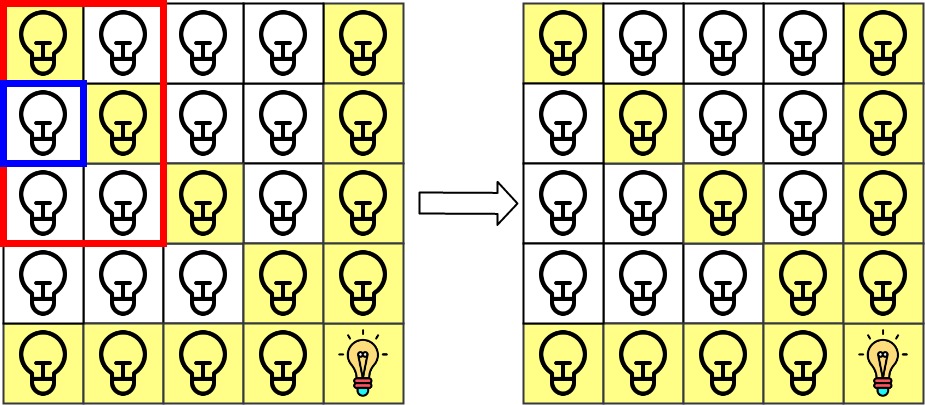英文原文
There is a 2D grid of size n x n where each cell of this grid has a lamp that is initially turned off.
You are given a 2D array of lamp positions lamps, where lamps[i] = [rowi, coli] indicates that the lamp at grid[rowi][coli] is turned on. Even if the same lamp is listed more than once, it is turned on.
When a lamp is turned on, it illuminates its cell and all other cells in the same row, column, or diagonal.
You are also given another 2D array queries, where queries[j] = [rowj, colj]. For the jth query, determine whether grid[rowj][colj] is illuminated or not. After answering the jth query, turn off the lamp at grid[rowj][colj] and its 8 adjacent lamps if they exist. A lamp is adjacent if its cell shares either a side or corner with grid[rowj][colj].
Return an array of integers ans, where ans[j] should be 1 if the cell in the jth query was illuminated, or 0 if the lamp was not.
Example 1:

Input: n = 5, lamps = [[0,0],[4,4]], queries = [[1,1],[1,0]] Output: [1,0] Explanation: We have the initial grid with all lamps turned off. In the above picture we see the grid after turning on the lamp at grid[0][0] then turning on the lamp at grid[4][4]. The 0th query asks if the lamp at grid[1][1] is illuminated or not (the blue square). It is illuminated, so set ans[0] = 1. Then, we turn off all lamps in the red square.The 1st query asks if the lamp at grid[1][0] is illuminated or not (the blue square). It is not illuminated, so set ans[1] = 0. Then, we turn off all lamps in the red rectangle.

Example 2:
Input: n = 5, lamps = [[0,0],[4,4]], queries = [[1,1],[1,1]] Output: [1,1]
Example 3:
Input: n = 5, lamps = [[0,0],[0,4]], queries = [[0,4],[0,1],[1,4]] Output: [1,1,0]
Constraints:
1 <= n <= 1090 <= lamps.length <= 200000 <= queries.length <= 20000lamps[i].length == 20 <= rowi, coli < nqueries[j].length == 20 <= rowj, colj < n
中文题目
在 N x N 的网格 grid 上,每个单元格都有一盏灯,最初灯都处于 关闭 状态。
数组 lamps 表示打开的灯的位置。lamps[i] = [rowi, coli] 表示 打开 位于 grid[rowi][coli] 的第 i 盏灯 。每盏灯都照亮自身单元格以及同一行、同一列和两条对角线上的所有其他单元格。
查询数组 queries 中,第 i 次查询 queries[i] = [rowi, coli],如果单元格 [rowi, coli] 是被照亮的,则查询结果为 1 ,否则为 0 。在第 i 次查询之后 [按照查询的顺序] ,关闭 位于单元格 grid[rowi][coli] 上或其相邻 8 个方向上(与单元格 grid[rowi][coli] 共享角或边)的任何灯。
返回答案数组 ans , answer[i] 应等于第 i 次查询 queries[i] 的结果,1 表示照亮,0 表示未照亮。
示例 1:

输入:N = 5, lamps = [[0,0],[4,4]], queries = [[1,1],[1,0]] 输出:[1,0] 解释:最初所有灯都是关闭的。在执行查询之前,打开位于 [0, 0] 和 [4, 4] 的灯。第 0 次查询检查 grid[1][1] 是否被照亮(蓝色方框)。该单元格被照亮,所以 ans[0] = 1 。然后,关闭红色方框中的所有灯。第 1 次查询检查 grid[1][0] 是否被照亮(蓝色方框)。该单元格没有被照亮,所以 ans[1] = 0 。然后,关闭红色矩形中的所有灯。

示例 2:
输入:N = 5, lamps = [[0,0],[4,4]], queries = [[1,1],[1,1]] 输出:[1,1]
示例 3:
输入:N = 5, lamps = [[0,0],[0,4]], queries = [[0,4],[0,1],[1,4]] 输出:[1,1,0]
提示:
1 <= N <= 1090 <= lamps.length <= 20000lamps[i].length == 20 <= lamps[i][j] < N0 <= queries.length <= 20000queries[i].length == 20 <= queries[i][j] < N
通过代码
高赞题解
草稿

思路
就如草稿中打的那样,我觉得每一个灯点亮的时候,它都会影响“整行”,“整列”,“正对角线”,“反对角线”。

如果两个灯在一行,我们显而易见可以得知这一行一定会被点亮。同时我们知道,如果我们熄灭其中一盏灯,这一行依旧充满光明!因为还有另一盏灯依然坚挺!只有当两盏灯同时熄灭,这一行才会重新回归黑暗。但是被熄灭的灯所处的列以及对角线波及到的区域,都会在它熄灭的同时,也陷入黑暗。

这让我们可以进行第一次抽象,看成每一盏灯的点亮都会对波及到的格子进行“计数+1”。而每一盏灯的熄灭都会对波及到的格子进行“计数-1”。
这样,如图,两盏同一行的灯,所处的行的计数就会变成2。这意味着,只有当两盏灯同时熄灭,才能让这一行的计数变成0(也就是变黑)。
但是问题来了,题目中给出的N的大小最大是10的九次方。显然,不可能开辟一个足够大的数组空间可供挥霍(时间也不允许)。
接下来,于是就如开头草稿中写的,我们可以设计四个记录器。之所以设计记录器是因为,每点亮一个灯,就必然会点亮“一行”,“一列”,“一个正对角线”,“一个反对角线”。我们不再需要去记录每一个格子的“光源亮度”。
我们查看一个格子的光源亮度,也只需要去看“这一行是否被点亮”,“这一列是否被点亮”,“这一个正对角线是否被点亮”…只要这些条件中,任一一个满足,就说明这个格子是被点亮的。
行记录器的索引和列记录器的索引是非常好确定的,可以直接等于所处格子的横纵坐标。
而正反对角线记录器的索引确定方式,我写在了草稿中。
至于最终记录器的实现方式,最开始想当然的使用了数组(草稿中也列出了数组的大小)…但忽略了题目N的给定范围,最终使用HashMap实现了记录器。
class Solution {
//四个记录器
HashMap<Integer, Integer> colRecorder;
HashMap<Integer, Integer> rowRecorder;
HashMap<Integer, Integer> positiveRecorder;
HashMap<Integer, Integer> negetiveRecorder;
//一个灯光记录器
HashMap<Integer, Integer> lampsRecorder;
//初始化方向向量
private int[] dy = {-1, -1, -1, 0, 0, 0, 1, 1, 1};
private int[] dx = {-1, 0, 1, -1, 0, 1, -1, 0, 1};
private int directionLen = 9;
private int N;
public int[] gridIllumination(int N, int[][] lamps, int[][] queries) {
//...
}
private int getPositiveIndex(int y, int x) {
return x + y;
}
private int getNegetiveIndex(int y, int x) {
return y - x + N - 1;
}
}
统计信息
| 通过次数 | 提交次数 | AC比率 |
|---|---|---|
| 2221 | 7475 | 29.7% |
提交历史
| 提交时间 | 提交结果 | 执行时间 | 内存消耗 | 语言 |
|---|
相似题目
| 题目 | 难度 |
|---|---|
| N 皇后 | 困难 |




